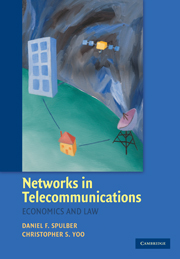Introduction
Published online by Cambridge University Press: 05 June 2012
Summary
The purpose of this book is to examine the implications of network theory for public policy toward communications. Network theory provides a highly useful and powerful tool for modeling and understanding communications networks. Network theory opens the “black box” of networks to reveal the complexities of network architecture. Rather than working with the reduced form of the standard economic cost function, network theory pays attention to the nodes and links that form networks. The architecture of networks affects transmission capacity and the quality of service. The structure of networks also is important for understanding the boundaries of private networks provided by individual firms and the interconnections between networks. By applying network theory to communications, we develop a general Coasian theory of networks.
Using network theory, we develop a comprehensive framework for analyzing public policy toward communications. The discussion identifies the shift in regulatory policy from utility regulation to mandated access. Access to networks refers to the market transactions that connect a firm's network to its customers, suppliers, competitors, and partners. Our discussion presents a classification scheme for analyzing access to networks. We apply network theory based on the mathematics of graph theory tools to characterize the structure of networks. We examine how regulatory access mandates can distort access price. In competitive markets, optimization by firms and access transactions lead to efficient network boundaries and interconnections. Regulatory access mandates potentially reduce economic efficiency by changing the market-equilibrium structure and boundaries of communications networks.
- Type
- Chapter
- Information
- Networks in TelecommunicationsEconomics and Law, pp. 1 - 10Publisher: Cambridge University PressPrint publication year: 2009



